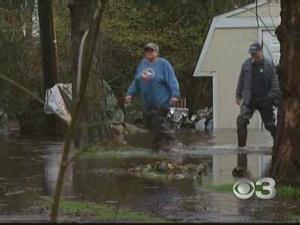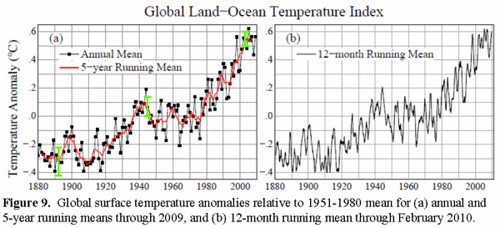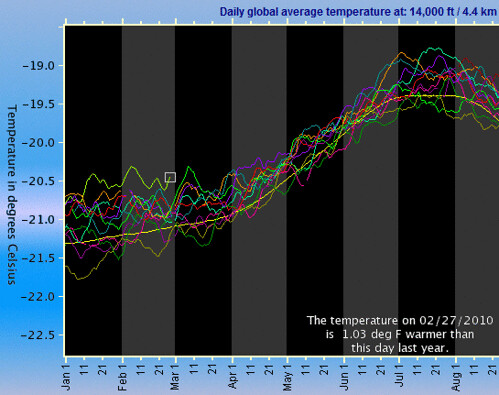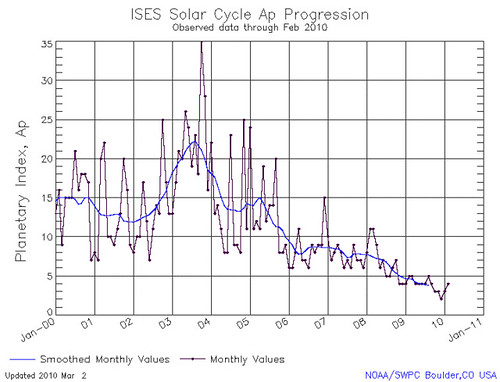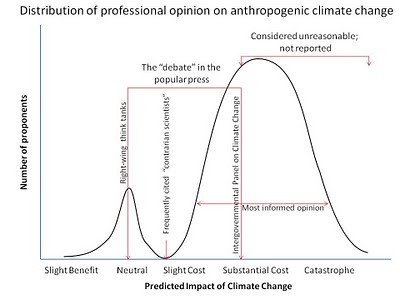Study: “It is clear … that the precipitous decline in September sea ice extent in recent years is mainly due to the cumulative loss of multiyear ice.”
Physicist: "If temperatures change just a few tenths of a degree then this oh-so-thin ice cap is doomed."
Joseph Romm, Climate Progress, March 22, 2010
Memo to media: Ignore the misreporting on the Arctic that focuses on sea-ice extent or area. The big Arctic news is the staggering decline in multiyear ice — ice volume. No study has yet been published undermining our understanding that human emissions are the primary cause of that long-term decline — a decline that shows no sign of reversal.

The real news from the Arctic is the staggering decline in thicker, multi-year ice [red line] — as seen in the above figure from leading cryoscientists who authored the 2009 study, “Thinning and volume loss of the Arctic Ocean sea ice cover: 2003–2008” (discussed
here). Studies that focus on trying to correlate sea ice extent (i.e. area) with variables that might reduce ice cover border on purely pointless right now because:
- Trends in multi-year ice — ice volume — are what matter most in terms of the long-term survivability of the Arctic ice in the summer (see New study supports finding that “the amount of [multi-year] sea ice in the northern hemisphere was the lowest on record in 2009″).
- It now appears that an unfortunate trick of Nature helped hide the ongoing decline of Arctic ice from satellite and other measurements — measurements that suggested two-dimensional recovery of sea ice extent in 2009. See the study “Perennial pack ice in the southern Beaufort Sea was not as it appeared in the summer of 2009.”
The latest media mashup began with a new study in
Geophysical Research Letters (subs. req’d), “
Influence of winter and summer surface wind anomalies on Summer Arctic sea ice extent.” The study, by Masayo Ogi et al., finds that:
... the combined effect of winter and summer wind forcing accounts for 50% of the variance of the change in September Arctic sea ice extent from one year to the next (ΔSIE) and it also explains roughly 1/3 of the downward linear trend of SIE over the past 31 years.
That became a
Guardian story by David Adam with an especially misleading subhead:
Wind contributing to Arctic sea ice loss, study finds
New research does not question climate change is also melting ice in the Arctic, but finds wind patterns explain steep decline
And of course we have a
Daily Mail story by the infamous “Daily Mail Reporter”:
Arctic winds and not global warming ‘responsible for much of record loss of sea ice’
As an aside, I understand why “Daily Mail Reporter” wants to stay anonymous — he or she is a dreadful journalist at a dreadful newspaper (see “
DailyMailGate: Error-riddled articles and false statements destroy Daily Mail’s credibility”).
The anti-science disinformers are dancing over this study, but they are dancing on thin ice — like
a certain ice skater we know.
First off, this study isn’t even news! As I blogged almost 2 years ago, a
GRL study, “
What drove the dramatic retreat of arctic sea ice during summer 2007?” concluded:
… preconditioning, anomalous winds, and ice-albedo feedback are mainly responsible for the retreat. Arctic sea ice in 2007 was preconditioned to radical changes after years of shrinking and thinning in a warm climate.… The Arctic Ocean lost additional 10% of its total ice mass in which 70% is due directly to the amplified melting and 30% to the unusual ice advection, causing the unprecedented ice retreat. Arctic sea ice has entered a state of being particularly vulnerable to anomalous atmospheric forcing.
So the June 2008
GRL study found 30% of the sharp drop in sea ice in 2007 was due to “unusual ice advection” — and the new study says 1/3 of the downward linear trend in SIE is due to wind forcing. The new study seems to confirm the older study (without ever referencing it).
The bigger point is the long-term trend is driven by human-driven warming, which makes the thinning ice more vulnerable to anomalous winds (assuming of course that the winds are anomalous and not themselves driven by climate change). So the story is an old one. What’s new is the disinformers are better at spinning these studies, and the media has gotten worse at actually reporting the science.
Indeed, Masayi Ogi also led another recent study (12/08), “
Summer retreat of Arctic sea ice: Role of summer winds” (subs. req’d) that concluded:
The six summers that exhibited highest values of the SLP [sea level pressure] index (1995, 1998, 1999, 2005, 2007 and 2008) were all in the last half of the record. September SIE reached record lows in three of these years (1995, 2005, and 2007), and it nearly tied the record in 2008. Yet it is clear from Figure 4c that the precipitous decline in September SIE in recent years is mainly due to the cumulative loss of multiyear ice: summertime SLP anomalies have played an important role in setting the timing of record lows, but the long term trend is mainly due to preconditioning.
In other words
, Ogi’s studies do
nothing whatsoever to undermine the view that the long-term trend in Arctic sea ice — extent and volume — is being driven by human-caused warming.
That paragraph and the new study make clear the SLP index and winds have been higher more recently. As the
Guardian notes, “
These winds have increased recently, which could help explain the apparent acceleration in ice loss.” The climate is changing everywhere and humans are the primary cause.
Unless the authors (or anyone else) can show that this increase in winds is not also due to climate change, then their study again does nothing to undermine the view that the long-term trend is being driven primarily by human-caused warming.
Finally, the latest study is based on correlating sea ice extent (SIE) with other factors, like Arctic winds. But another recent study — “
Perennial pack ice in the southern Beaufort Sea was not as it appeared in the summer of 2009” (subs. req’d) by Barber et al. — suggests that standard measures of SIE extent may be unreliable. I discussed that study here: “
Where on Earth is it unusually warm? Greenland and the Arctic Ocean, which is full of rotten ice.” It found:
In September 2009 we observed a much different sea icescape in the Southern Beaufort Sea than anticipated, based on remotely sensed products. Radarsat derived ice charts predicted 7 to 9 tenths multi-year (MY) or thick first-year (FY) sea ice throughout most of the Southern Beaufort Sea in the deep water of the Canada Basin. In situ observations found heavily decayed, very small remnant MY and FY floes interspersed with new ice between floes, in melt ponds, thaw holes and growing over negative freeboard older ice. This icescape contained approximately 25% open water, predominantly distributed in between floes or in thaw holes connected to the ocean below. Although this rotten ice regime was quite different than the expected MY regime in terms of ice volume and strength, their near-surface physical properties were found to be sufficiently alike that their radiometric and scattering characteristics were almost identical.
Yes, satellite (and other) measurements of Arctic sea ice extent were apparently deceived by rotten ice. [Hmm, is that why they call it rotten?]
You might even say that an unfortunate trick of Nature helped hide the decline of Arctic ice:
This case of mistaken identity is physically explained by the factors which contribute to the return to Radarsat-1 from the two surfaces; both ice regimes had similar temperature and salinity profiles in the near-surface volume, both ice types existed with a similar amount of open water between and within the floes, and finally both ice regimes were overlain by similar, recently formed new sea ice in areas of negative freeboard and in open water areas. The fact that these two very different ice regimes could not be differentiated using Radarsat-1 data or in situ C-band scatterometer or microwave radiometer measurements, has significant implications for climate studies and for marine vessel navigation in the Canada Basin.
Given Barber’s work calling into question traditional measures of SIE, I don’t know how much faith one can put in statistical analyses that correlate SIE with other variables. Barber himself
says:
“I would argue that, from a practical perspective, we almost have a seasonally ice-free Arctic now, because multiyear sea ice is the barrier to the use and development of the Arctic,” said Barber [Canada's Research Chair in Arctic System Science at the University of Manitoba].
Revkin has another
Goldilocks post leaping on this study, linking to some of my much older posts, not the ones about Barber’s work. He quotes one expert noting that the unusual conditions in the Arctic this winter — in particular the highly negative Arctic oscillation — may lead to less ice retreat. Certainly it might lead to less observed sea ice retreat, but then again, this is likely to be the hottest year on record — and certainly we now know that atmospheric conditions do have an impact on year-to-year fluctuations in apparent SIE — so the jury is out on this summer. In any case, we also know the traditional measurements of SIE may not be reliable and thus may well lowball the actual retreat.
Most importantly, we know that thickness matters much more than area. And in that regard, we have seen no significant recovery. Nor are we likely to, according to one of Revkin’s own experts, “Rhett Herman, a physics professor at Radford University, [who] has been leading students on an expedition each spring break to study the condition of the sea ice off the coast near Barrow, Alaska.” Last week, Revkin quoted
Herman:
We’re also seeing just how frighteningly thin the ice is. When asked about the thickness of the north polar ice cap many people say things such as “hundreds of feet” and “thousands of feet” and “very thick like the South Pole.” None of these are true. The average thickness of the sea ice over the entire north polar ice cap is only a few meters! There isn’t much ice here, and that’s a major problem. If temperatures change just a few tenths of a degree then this oh-so-thin ice cap is doomed.
Well, we’re pretty much stuck with another 0.6 °C warming even if GHG concentrations don’t rise further — and NASA
just reported, “there has been no reduction in the global warming trend of 0.15-0.20 °C/decade that began in the late 1970s.”
Many other leading experts share a similar view. Peter Wadhams, head of the polar ocean physics group at the University of Cambridge, “
believes the ice, which has been a permanent feature for at least 100,000 years, is now so thin that almost all of it will disappear in about a decade.”
Back in October, National Snow and Ice Data Center Research Scientist Walt Meier wrote me:
There is significant natural variability in the climate system, and particularly the sea ice. It is only by looking at long-term trends, after the short-term variability is averaged out, that you can make any judgments on long-term climate factors…
In the short term, winds can play an important role in the sea ice extent. If there are winds pushing the ice edge “inward,” then you either increase the seasonal decline or slow (or even temporarily reverse) the seasonal increase, depending on the season.
What about
NSIDC director’s Mark Serreze “death spiral” of Arctic ice metaphor? I noted back then that the
NYT’s Revkin had written:
So the “death spiral of the Arctic ice system” could well be more like a series of descending loop the loops.
Meier wrote:
Andy Revkin’s comment is quite apt. We don’t expect to see a continual downward trend, there will some fits and starts, but the overall trend will continue to be down.
NSIDC director Serreze then wrote me that “I share Walt’s views.”
So the ice cap is apparently doomed — and the overwhelming majority of CP readers will probably live to see an ice-free summer Arctic. I’ll end with this figure of mean monthly Ice Volume for the Arctic Ocean from
a release by several scientific institutions:

I still like my odds on a 90% ice free Arctic by 2020 (see “
Another big climate bet — Of Ice and Men“). By then, I assume they’ll have figured out how to deal with Nature’s sea-ice-decline-hiding trick — or there will simply be too little ice for anybody to be fooled.
Link to above post at Climate Progress:
http://climateprogress.org/2010/03/22/thin-ice-arctic-winds-sea-ice-extent-global-warming/
Selected comments:
Joe,
I’m sure Rhett Herman, who contributed the Dot Earth “postcard” on his students’ fieldwork, will readily admit that while he’s a great teacher (and that’s why that post was done) he is not a heavily published specialist on sea-ice trends and drivers. Stacking his informal comment against the input of a heap of published sea-ice specialists (see my coverage since 2000) seems a bit strained?
[
JR: Honestly, Andy. You quote this guy at length on your blog, and now walk away from him. You always tout your group of Arctic experts. How am I supposed to know which experts you quote that you believe and which you don't! I did NOT stack his comment against anything. His comment is consistent with many experts I have quoted. This quote just happened to be new and from DotEarth. How about this -- Peter Wadhams, head of the polar ocean physics group at the University of Cambridge, “believes the ice, which has been a permanent feature for at least 100,000 years, is now so thin that almost all of it will disappear in about a decade“:]
The reason I didn’t write on Dave Barber’s paper when it came out (even though he was featured in our 2005 Discovery-Times “Arctic Rush” documentary and is a highly regarded scientist), is that I got a lot of pushback from a batch of Arctic Ocean ice specialists who immediately said that the Beaufort is a special case and cited various reasons to handle those findings cautiously. I may revisit and query Dr. Barber and them anew. That’s how I try to avoid what I call “whiplash journalism” (or blogging). Covering every paper can lead to real neck trauma when focused on the more complicated parts of climate science (even as the basics are clear).
[
JR: So you only cover the published peer-reviewed papers that your group of experts are okay with? Awesome. Essentially, you are negatung the peer review process. So these "batch of Arctic Ocean ice specialists" apparently aren't reviewers who can affect the content of the piece before it is published.
BTW, aren't you now a blogger? What was the point of that comment?
And you are missing half the reason I'm quoting Barber -- his research calls into question the accuracy of traditional SIE measurement, which in turn calls into question any effort to do correlations between SIE and other variables! I can see why that by bother your specialists.]
I don’t imagine you tried contacting any other ice scientists before publishing your posts on the Beaufort finding? (I know, my need to check things out is just the old retro journalist trait in me.)
[
JR: Again, if I understand your methodology, you ask your group of experts about peer-reviewed science and if they don't like it then maybe you don't write about it. Not what I do. Sometimes I talk to other scientists, sometimes I don't. Depends on the study. You don't actually have to contact other scientists to write about a new peer-reviewed paper -- especially if you are very familiar with the peer-reviewed literature and especially if this study pretty much agrees with one that was written two years ago! In this case, it seemed clear to me it was being misreported, and I wanted to correct the record.]
Finally, you forgot to mention the paragraph in my post where I expressly described the great spasm-like flushes of the true multi-year (as opposed to young two-year-old) ice you focus on. Those big flushes show the situation up there is not nearly as simple as some would like it to be. Don’t take my word for it, though. This animation from Ignatius Rigor at U. of Washington vividly shows the big pulses of lost meters-thick ice (long before the losses that you highlight above):
http://www.youtube.com/watch?v=Co68_tod0dQ
[
JR: Awesome. Looks like a death spiral for me. I take it this is one of the experts you quote whom you actually believe. Is this in the peer-reviewed literature, because I would like the link, if so. In any case, the last time I checked, 1989 was the tail end of what was the hottest decade on record at the time, before the 1990s became the hottest decade on record, and before the 2000s overtook them both. I don't focus on two-year-old ice -- I do cite peer-reviewed literature on multiyear ice.
I can't imagine anybody reading this post would come away with the impression that I think this situation is "simple." Obviously the apparent SIE is affected by many things year-to-year, just like the apparent global temperature. But the ice volume appears much less susceptible to such fluctuations and appears to be doomed.]
Here’s video I shot of one of the processes that generates such ice (also a function of ice motion, not just temperature):
http://www.youtube.com/watch?v=axsSexPoSR0
I really do think you need to take a field trip sometime.
Volume is important, but the heat content of the remaining sea ice is also of interest. Dr. Barber suggests, and satalite data confirms that the remaining ice may already have absorbed most of the heat it needs to melt. And, this is in situ HEATING not wind. Cold hard ice would have been strong enough to not blow through the straits. The same satalite data tells me that the Ross ice shelf and the sea ice on the Weddle sea are also absorbing heat from the warming oceans below.
The figures below (Rothrock, et al., 1999, and Kwock & Rothrock, 2009) show sea ice thickness has substantially declined. Using data from submarine cruises, Rothrock and collaborators determined that the mean ice draft at the end of the melt season in the Arctic has decreased by about 1.3 meters between the 1950s and the 1990s.
http://www2.sunysuffolk.edu/ mandias/ global_warming/ images/ sea_ice_draft.gif
When combining this data with recent satellite data:
http://www2.sunysuffolk.edu/ mandias/ global_warming/ images/ sea_ice_draft_composite.gif
“The overall mean winter thickness of 3.64 m in 1980 can be compared to a 1.89 m mean during the last winter of the ICESat record—an astonishing decrease of 1.75 m in thickness. Between 1975 and 2000, the steepest rate of decrease is 0.08 m/yr in 1990 compared to a slightly higher winter/summer rate of 0.10/0.20 m/yr in the five-year ICESat record (2003–2008). Prior to 1997, ice extent in the DRA was >90% during the summer minimum. This can be contrasted to the gradual decrease in the early 2000s followed by an abrupt drop to <55% during the record setting minimum in 2007. This combined analysis shows a long-term trend of sea ice thinning over submarine and ICESat records that span five decades."


